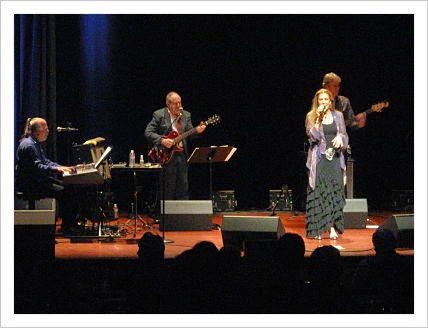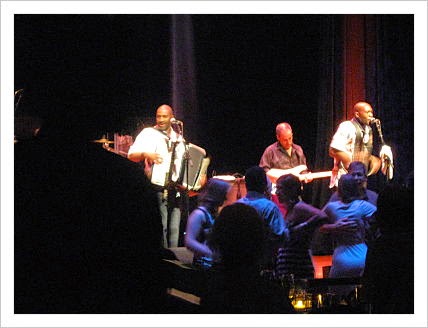She'll turn 70 next year, but she sure doesn't look it, act it, or sing like it.
Instead, Rita Coolidge sings like she did after she graduated from college and tried her talents on stage, thrilling fans with her classy, signature voice which she did again Sunday evening for a crowd at the Bethesda Blues & Jazz Supper Club.
Rita Coolidge at the Bethesda Blues & Jazz Supper Club/Photo by Patricia Leslie
She opened with a number she sang long ago and oh so far away which the Carpenters made legendary, "Superstar," a song no one wanted her to stop singing.
 Rita Coolidge at the Bethesda Blues & Jazz Supper Club/Photo by Patricia Leslie
Rita Coolidge at the Bethesda Blues & Jazz Supper Club/Photo by Patricia LeslieDazzling in a ruffled long black dress with curving hemline, silver clasp and lilac wrap, Rita looked like she may weigh all of 100 pounds. And her long hair may account for half that weight.
 Rita Coolidge at the Bethesda Blues & Jazz Supper Club with John Thomas on keys; John McDuffie (center), guitar, and Randy Landas, guitar/Photo by Patricia Leslie
Rita Coolidge at the Bethesda Blues & Jazz Supper Club with John Thomas on keys; John McDuffie (center), guitar, and Randy Landas, guitar/Photo by Patricia LeslieRita is her own, who can handle the singing herself, without echoes or fake background voices.
 John McDuffie on a mean red guitar with Rita Coolidge at the Bethesda Blues & Jazz Supper Club. Behind him is Randy Landas/Photo by Patricia Leslie
John McDuffie on a mean red guitar with Rita Coolidge at the Bethesda Blues & Jazz Supper Club. Behind him is Randy Landas/Photo by Patricia LeslieIn the romantic, sexily lighted Jazz Club hall, she sang "Basic Lady," and when she got to Peggy Lee's "Fever," you got it.
The first time she heard Peggy Lee sing the song, Rita was just three years old, she said. It put a spell on the young listener, and right then and there: "I knew what I wanted to be. I knew I wanted to be here tonight, and here I am." She credited Bethesda's Blues owner, Rick Brown, for bringing her to Washington.
Rita Coolidge at the Bethesda Blues & Jazz Supper Club/Photo by Patricia Leslie
Her most beautiful song of the night was the Cherokee National Anthem, sung by her ancestors in the 1830s while they traveled the Trail of Tears after President Andrew Jackson kicked them out of the Deep South. The music is reminiscent of "Amazing Grace," and can be as emotionally wrenching for listeners as it is for vocalists. Rita was born in Lafayette, Tennessee to a Cherokee father and a Scottish/Cherokee mother.
Reading the titles of many of her hits she sang at the Jazz Club may enable them to start spinning in your head: "We're All Alone," (Your Love Has Lifted Me) "Higher and Higher," "The Way You Do the Things You Do," and "Can't Stand The Rain."
Also, "How Sweet It Is (To Be Loved By You)," and Bob Dylan's affable, "I'll Be Your Baby Tonight," which she varied with a slower, sexier arrangement from Dylan's version.
 Lynn Coulter was the drummer for Rita Coolidge's show at the Bethesda Blues & Jazz Supper Club. He and Rita made sweet harmony in "Loving Arms"/Photo by Patricia Leslie
Lynn Coulter was the drummer for Rita Coolidge's show at the Bethesda Blues & Jazz Supper Club. He and Rita made sweet harmony in "Loving Arms"/Photo by Patricia LeslieShe mentioned her ex, Kris Kristofferson (married 1973-1980) and the joy they share in their only child, a daughter, Casey, and three granddaughters. Next spring HarperCollins will publish Rita's autobiography.
Most in the audience stood and applauded when the two hour set ended. Rita Coolidge bowed, and in her graceful way, exited the stage, to return seconds later for the encore and "I'd Rather Leave When I Am In Love" and "Lover, Please, Please Come Back." We will, Rita!
If your experience is like mine at the Bethesda Blues and Jazz Supper Club, you and your party will spend a totally delightful evening listening to fantastic music in an intimate setting with drinks and/or dinner, and you may be kicking up a heel or two for some of the acts come with dancing, theirs and yours. Cowboy hats, welcome.
What: Bethesda Blues & Jazz Supper Club
When: 12 p.m.-1 a.m., Monday-Saturday; 12 p.m.-12 a.m., Sunday
Where: 7719 Wisconsin Avenue, Bethesda, MD 20814
How much: Prices vary, depending upon artist. See the calendar.
Food and drink: The dining area has a $10 per person minimum which can be applied toward any item on the menu. Check out FAQ here. And here's the menu. I found the food (beet salad: yummy) and drinks, good and reasonably priced.
Tickets: Call 240-330-4500 or go to the website.
Getting there: The Bethesda Metro station is about 1.5 blocks away, and parking is below the building (free on weekends). See directions.
For more posts on Rita Coolidge and the Bethesda Blues & Jazz Supper Club, please click on the links.
patricialesli@gmail.com














.jpg)















